 Life & Style
Life & Style

Spring time festivities that take place all over the country can be great occasions to enjoy the nation's cultural and culinary diversity. In Cao Bằng Province, some dishes made by the Tày and Nùng Ethnic minorities incorporate wild leaves and fruits not easily found elsewhere.
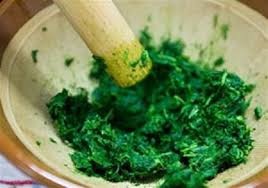 |
| Green pulp: Grinding ngải cứu to make the cake.—Photos dulichcaobang.com |
By Hà Nguyễn
Spring and the Lunar New Year is a great time for many obvious reasons.
The weather is perfect, or close to perfect, and many traditional festivals are celebrated throughout the country, each with features distinct to the region, whether it is the associated legend, musical tradition or religious ritual.
It also happens to be the best season for visitors to discover many culinary specialties, some of them more uncommon and unusual than others.
HCM City residents Nguyễn Kiều Lâm and her two sons recently visited the northern province of Cao Bằng. They wanted to see the famous, historic Pác Bó cave and the Thác Bản Giốc Waterfall. A couple of festivals at the King Lê and Na Sầm temples were also part of their itinerary.
“We enjoyed the beautiful landscapes everywhere, but what stands out for us as most special are the tasty dishes served by the Tày or Nùng ethnic minority vendors at traditional festivals,” Lâm said.
Lâm said her two sons could not have enough of a dish called lợn quay (roast pig). The pieces were soft and its golden red or reddish brown skin so crispy that they wanted to eat more even after finishing of a large portion.
Lâm’s elder son Hồ Nguyên Ngọc said it was the first time that he was enjoying such an aromatic and tasty dish, the fragrance of the dipping sauce made with mác mật leaves (a kind of wild wampee tree found in the province) making it very special.
He asked Nông Ích Lai, a Tày man in Hòa An District (about 15km from the downtown Cao Bằng City), to please reveal what made the dish so irresistible.
Lai, who has sold lợn quay for more than 20 years at festivals in his district and in the city, was kind enough to indulge Ngọc.
Lai said that before Tết arrived, he would go to remote communes in Nguyên Bình District to buy organic pigs of about 20-25kg per pig each and raise them at home.
“I mix the mác mật leaves with dried onions, garlic, fish sauce, salt, and a pinch of traditionally made spice and put all the dumplings in the pig’s belly and sew it well before pouring a small cup of wild honey on the pig.”
He said roasting technique was rather difficult. The pig had to be turned regularly over a wood charcoal fire for about three hours. If it was not done properly, the pig could get burned, the meat could become dry and the skin would not be crispy.
Apart from lợn quay, Lâm and her sons also tasted ngải cứu and mò mè xu héc cakes made by the Tày and Nùng ethnic groups in the province.
Lai’s neighbor Đoàn Thị Huyến, a famous wampee cake maker in the district, got the recipe from her grandmother.
“ I have to wake up very early in the morning to pick up the wampee fruit from my garden to ensure its freshness and then boil it in a special “ashes water” for between two and three hours until it is well-cooked.
“Then the ngải cứu leaves should be carefully washed and then mixed with glutinous rice powder. The cake’s dumpling is a mix of ground fried black sesame and cane sugar,” Huyến.
The cake can be steamed or fried, but steamed is healthier, she said.
Lâm said she enjoyed the cake’s combination of fragrant glutinous rice powder and the special flavor of ngải cứu leaves “so much.”
“I could feel it cooling my body and satisfying craving taste,” Lâm said.
Local herbalist Tạ Ngọc Oánh, 70, said the leaves are particularly good for pregnant women and the elderly.
The leaves, apart from being nutritious, help reduce pain from injury, provide relief from itching, and is good for treating colds and headaches, as also improve blood circulation, Oánh said..
“I’ve used the leaves to treat my patients, and many of them with these ailments have recovered,” he said, reiterating that the ngải cứu cake is very good for human’s health.
Oánh’s wife, Nông Thị Tiếu is famous for her mò mè xu héc, a traditional cake made by the Tày and Nùng people.
This cake is also made from glutinous rice but knead into the shapes of animals such as buffalo, cow, pig, dog, cat, and bird. After kneading and shaping, the cakes are pan fried either in vegetable oil or pork fat. The crispy, chewy and sweet taste makes these cakes very popular at local festivals.
Tiếu said her mother taught her to make to the cakes when she was a little girl. “It sells particularly well at festivals. Children enjoy it a lot.” — VNS
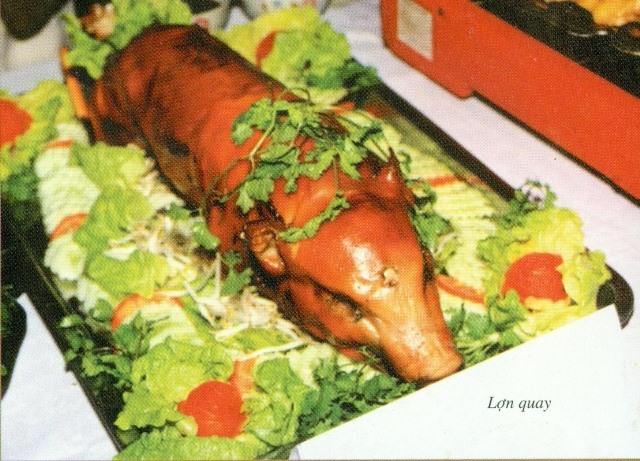 |
| Done to a turn: Roast pig sells very well at Spring festivals. |
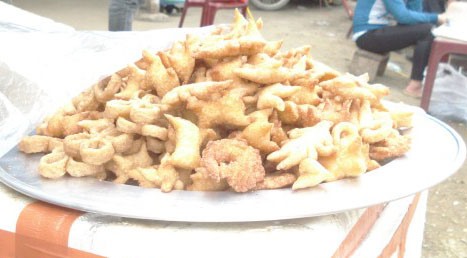 |
| Shapes and sizes: The mò mè xu héc cake is highly favoured by children. |
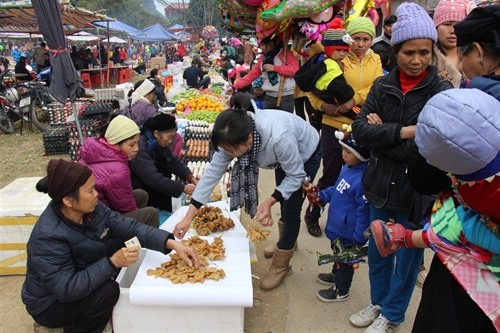 |
| Deep-fried treat: The mò me xu héc cake is sold at traditional festivals in Cao Bang province. |
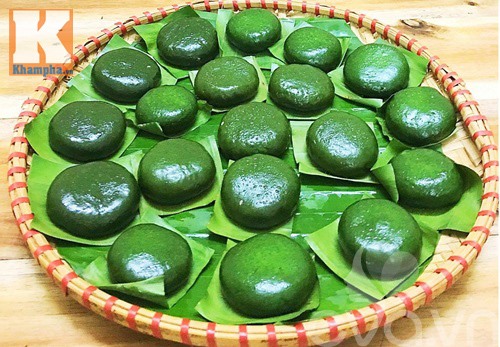 |
| Shades of green: The Ngải cửu (wampee) leaf cake is a specialty of the Tày and Nùng people in Cao Bằng Province.Photos dulichcaobang.com |




